Jellyfish Safety
Jellyfish, vary in both harmful and harmless varieties, and are a very common sight along our local coastlines and one of the effects of climate change is the increase in the water temperature in the Med which is nice for bathers, but this is also causing an increase in the number of jellyfish in the area.
Jellyfish have been around for millions of years, even before dinosaurs lived on the Earth. Pulsing along on our ocean currents, these jelly-like creatures can be found in waters both cold and warm, deep and shallow and along coastlines, too. Some jellyfish are clear, but others are vibrant colours of pink, yellow, blue and purple. They can be bioluminescent, too, which means they produce their own light!
They are normally in swarms, making them easily seen and, in theory at least, easily avoided. Jellyfish are normally to be found between 20 and 40 miles from the coast where the waters are warmer and saltier, However, summer weather will bring them in much closer to shore, when people are bathing, so sting numbers increase dramatically.
The numbers of jellyfish in any given year are dependent on several factors. A warm, dry winter and spring inland, for example, will normally lead to a high build-up of jellyfish at sea. However, when freshwater river input into the sea is lower due to lack of rain, salinity increases and this allows them to breach the barrier. Other factors include winds and sea currents as jellyfish just drift along in the currents.
Information about Beaches in Benidorm and The best Beaches on the Costa Blanca
Jellyfish safety App Available
Medusapp allows anyone to warn of sighting of a jellyfish and offer in real time a map of the places where their presence is detected.
Links to the App can be found here and are in English as well https://medusapp.net/

Medusapp logo
Stay safe on the beaches always follow the life guards warning flag system.
Medusapp allows you to send both the photo of the species and the abundance and estimated size, data that is published on a map on www.medusapp.net and which can also be accessed from the application itself. The user can send a photo of the jellyfish, in the case of sightings; and in the bites, you can also send them, also explaining how long it has been since it was produced or type of species that has bitten you.
In addition, it is able to notify the user if there have been sightings in recent days within a radius of 5 km from their position, being able to generate a quick global report on the situation maps . "It is also possible to consult the sightings in any range of dates and / or species desired,"
A sketch of the human body has also been added , which helps indicate the bite area, new maps, as well as filters that make navigation through the application more accessible and friendly.
Didactic and first aid guide
The new version of Medusapp also has a didactic guide and images of the main jellyfish and an interactive first aid guide, with recommendations in case of bites/stings depending on the species. All this information comes from the LIFE Cubomed project, in which César Bordehore, a researcher at the UA, participates, together with personnel from the Institute of Marine Sciences of the CSIC in Barcelona.
Medusapp is available for both Android and iOS, and it works both online and offline in case there is no coverage or it is preferred to send from WiFi coverage once the information is collected.
Beach Safety
If you see this flag flying on the beach, do not enter the water, it may also be seen as just a purple flag and means the presence of possible dangerous marine life.
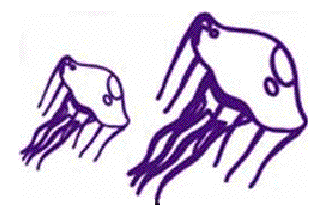
Jellyfish that can be found in the Mediterranean sea
The Portuguese man-of-war
June 2019 2 of Benidorm´s beaches were closed for a short while due to the sighting of 2 Portuguese man o war
This is very often mistaken for a jellyfish. Not only is it not a jellyfish, it’s not even an “it,” but a “they.” The Portuguese man-of-war is a siphonophore, an animal made up of a colony of organisms working together.
When a man o’ war stings, its long tentacles release thousands of microscopic venom-injecting capsules called nematocysts. On contact with skin, the nematocysts deliver a toxic chemical cocktail into its victim. The effects of this venom can range from mild to life threatening, but typically include immediate pain that can last upwards of 15 to 20 minutes. In more severe cases, a sting can trigger chest pain, difficulty breathing, and even death.
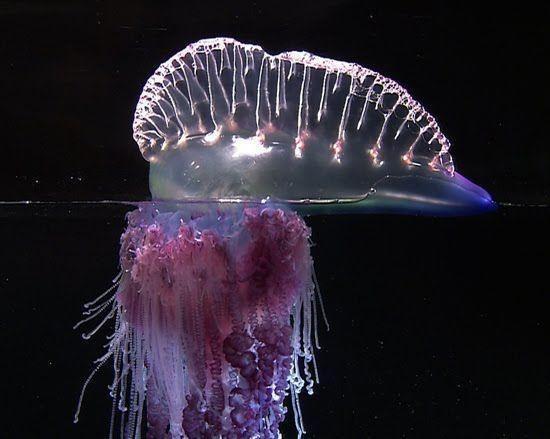
If you are stung the main thing is to remove the remains of tentacles with tweezers or a plastic card, without rubbing, and inactivate the stinging cells that could remain on the skin with a mixture of bicarbonate and seawater," recalls the expert in marine ecology of the UA.
Experiments show that the best way to treat a sting from a man o’ war is to rinse the wound with vinegar to remove any residual stingers or bits of tentacle left on the skin, and then immerse the wound in hot water—ideally at a temperature of 113 degrees F (45 degrees C)—for 45 minutes. A hot pack will substitute nicely for the hot water, even a quick, 30-second wash of diluted vinegar will help.
As for other treatments, such as alcohol, urine, baking soda, lemon juice, regular cola, and seawater, they will not really heap but are more likely to worsen stings.” The application of seawater—a fairly common prescription—can be particularly bad by spreading the stinging capsules over more skin area, making the situation worse.
If you spot or suspect you have seen a Portuguese man of war in the sea or on the beach please report it immediately to the nearest life guard or first aid point. But beware—even dead man-of-wars washed up on beach can deliver a sting.
Pelagia Noctiluca, Clavel jellfish
Known in English as the mauve stinger or the purple-striped jelly, In Latin, pelagia means "of the sea", nocti stands for night and luca means light as this jellyfish has the ability to glow in the dark.
Pelagia noctiluca are fairly small jellyfish with adults having a bell diameter of 3–12 cm (1.2–4.7 in), They range in colour from mauve, purple, pink, light brown to yellow.
These normally arrive at our shores around June.
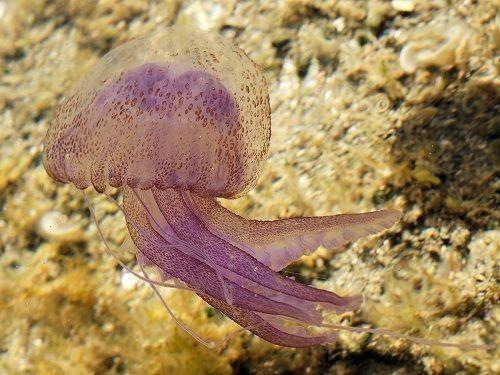
They are considered the most important stinging jellyfish in the Mediterranean Sea as both its tentacles and—unusual among jellyfish—the bell are covered in cnidocytes (stinging cells), and even recently dead, stranded individuals can sting.
The sting causes pain that typically lasts 1–2 weeks, local redness, swelling and a rash, but it is generally not dangerous and there are no known fatalities symptoms may be more general and include dizziness, vomiting and diarrhea. Sudden recurrent skin eruptions may occur years later. Rarely, the sting can cause a serious allergic reaction and leave scars or hyperpigmented marks on the skin that can remain for years after the encounter.
Cotylorhiza tuberculata, commonly known as Mediterranean jellyfish, Mediterranean jelly or fried egg jellyfish or Watercolour
Has a characteristic shape, with a flattened, yellowish-brown umbrella, and a prominent brown-orange central bulge, reminiscent of the shape of a fried egg. It is common in the Mediterranean.
It can reach 40 cm (16 in) in diameter, but is usually less than 17 cm (6.7 in) wide. The effects of its sting are very mild, not going beyond a slight itching and skin irritation. However it can cause allergies to more sensitive people, these allergies usually involve itching and scratching in the stung area.
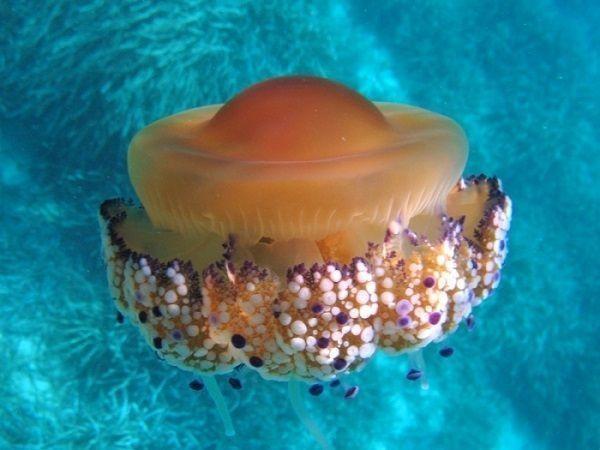
These are prominent from July to November and reproduce during August and October.
Blue jellyfish/Purple sailor jellyfish (velella velella)
Also know as Sailfish jellyfish as they have a kind of fin or sail with which they capture the wind to drift across the Mediterranean in large floating colonies.
Don´t panic if you see some of these jellyfish (velella velella) washed up on Benidorm´s beaches. These are NOT dangerous and will produce no reaction if they come into contact with the skin.
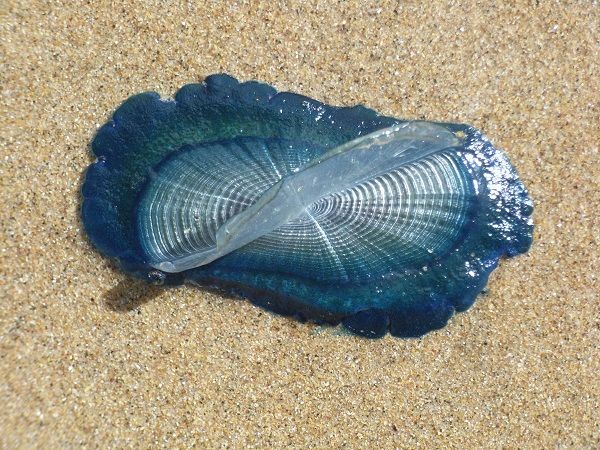
Treating Jellyfish Stings
Toxins stay in the tentacles even in dead jellyfish, so DO NOT touch them.
Find your nearest lifeguard for advice.
Symptoms can include
Burning in the contact area, tingling or stabbing pain.
Stinging.
Inflammation.
Throbbing pain.
If any tentacles remain stuck to the skin after exiting the water, remove them using a flat object (like a credit card). Do not rub them off with your hands (you don’t want more stings!) or a towel (which can aggravate the sting even more).
Rinse the sting with seawater or a saline mix. NEVER use fresh water, as due to differences in osmotic pressure, the remaining stinging cells could explode and spread more poison.
Next, deactivate the stingers: Rinsing with vinegar for at least 30 seconds works for some species, while a paste of baking soda and seawater works for sings caused by Portuguese man-of-war and sea nettle jellyfish.
Apply something cold (no more than 20 minutes) can be applied to the affected area using for example a plastic bag containing ice, to avoid inflammation and reduce pain. Do not apply ice directly as it can cause burns.
Relieve pain by soaking the sting in hot water for at least 20 minutes. Pain can be treated with a heat pack for some pain relief.
Apply insect bite creams that lists ‘…ocaine‘ as an ingredient.
Note: Despite the folklore, urinating on a jellyfish sting may actually cause the stingers to release more venom, rather than providing relief. Keep your pee to yourself.
It is also important to avoid exposing the wound to sunlight, and do not scratch it.
If there is continued swelling, or itchiness, apply a light steroid cream e.g. Hydrocortisone eczema cream.
• if muscle spasms persist see a doctor.



